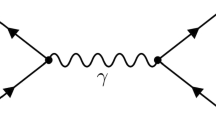Abstract
Within the quantum field theory, a new approach to the description of processes taking place at finite space-time intervals is considered. It is based on the Feynman diagram technique in the coordinate representation, in which the transition to the momentum representation is modified in accordance with the existing experimental situation. As a result, the Feynman propagator of particles in the momentum representation changes, while the other Feynman rules remain unchanged. In this approach, wave packets are not used and the initial and final states of particles are described by plane waves, which significantly simplifies the calculations. By example of the decay of an unstable particle and neutrino oscillations, it is shown how the differential probabilities of these processes can be found and that the results obtained agree with the expected ones.
Similar content being viewed by others
References
A. Pais and O. Piccioni, Phys. Rev. 100, 1487 (1955).
B. M. Pontecorvo, Sov. Phys. JETP 6, 429 (1957).
V. N. Gribov and B. M. Pontecorvo, Phys. Lett. B 28, 493 (1969).
R. Belušević, Springer Tracts Mod. Phys. 153, 1 (1999).
C. Giunti and C. W. Kim, Fundamentals of Neutrino Physics and Astrophysics (Oxford Univ. Press, UK, 2007).
C. Giunti et al., Phys. Rev. D: Part. Fields 48, 4310 (1993).
W. Grimus and P. Stockinger, Phys. Rev. D: Part. Fields 54, 3414 (1996).
M. Beuthe, Phys. Rep. 375, 105 (2003).
I. P. Volobuev, Int. J. Mod. Phys. A 33, 1850075 (2018).
V. O. Egorov and I. P. Volobuev, Phys. Rev. D: Part. Fields 97, 093002 (2018).
Acknowledgments
I am grateful to E.E. Boos, I.P. Volobuev, A.E. Lobanov, L.M. Slad’, and M.N. Smolyakov for useful discussions. Analytical calculations were performed using the COMPHEP and REDUCE software packages.
Funding
This work was supported by the Foundation for the Advancement of Theoretical Physics and Mathematics “BASIS”.
Author information
Authors and Affiliations
Corresponding author
Additional information
Russian Text © The Author(s), 2018, published in Yadernaya Fizika i Inzhiniring, 2018, Vol. 9, No. 6, pp. 569–573.
Rights and permissions
About this article
Cite this article
Egorov, V.O. A New Quantum Field Theory Approach to the Description of Finite-Time Processes. Phys. Atom. Nuclei 82, 1631–1634 (2019). https://doi.org/10.1134/S1063778819120081
Received:
Revised:
Accepted:
Published:
Issue Date:
DOI: https://doi.org/10.1134/S1063778819120081




